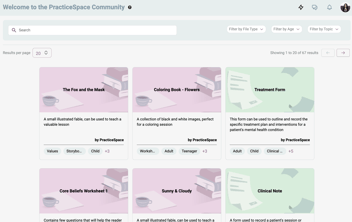The Virtual Engagement Gap for Therapists Working with Children
Virtual mental health care is no longer an option, it's now a necessity. Offering a convenient and accessible option for children and families seeking mental health support is imperative to the long-term success and evolution of the industry. However, despite the many benefits (e.g. closing distances, never missing an appointment, saving commute time, consistent experiences, minimizing costs, just to name a few), there are several barriers to giving proper virtual mental health care to children.
In this blog post, we will explore some of these challenges and discuss potential solutions.
- Lack of access to technology: One of the most significant barriers to virtual mental health care is the lack of access to technology. Many children and families may not have access to a reliable internet connection or a device that is suitable for video calls. This can be particularly challenging for families living in rural or remote areas, where internet access may be limited.
Solution: This is a massive problem, but one potential solution is to provide families with the necessary technology or offer virtual mental health care through community centres or schools. Providing families with a reliable internet connection or loaning devices can help bridge the digital divide and increase access to virtual mental health care.
- Privacy and security concerns: Privacy and security concerns are a significant barrier to virtual mental health care. Children and families may be hesitant to share sensitive information over a virtual platform, and there is always the risk of a breach of privacy or security.
Solution: Mental health professionals can address these concerns by using secure and encrypted platforms with modern, HIPAA compliant APIs, informing families of the security measures in place, and providing clear guidelines on how information will be stored and shared.
- Limited nonverbal cues: Nonverbal cues are essential in communication and play an important role in building trust and rapport. However, virtual mental health care can limit the ability to pick up on these cues. This is one reason why some mental health practitioners have moving online to be difficult.
Solution: Mental health professionals can compensate for the lack of nonverbal cues by using active listening skills, asking open-ended questions, and providing frequent feedback. Using video calls instead of phone calls can also help by observing facial expressions and body language.
- Difficulty engaging young children: Engaging young children in virtual mental health care can be challenging, as they may struggle to stay focused or may not fully understand the process.
Solution: Mental health professionals can engage young children by using age-appropriate activities and games, allowing for breaks, and involving parents or caregivers in the session, when appropriate and permitted under the laws in their province/state. Using play and art therapy as well as props or visual aids can also help to capture and maintain the child's attention.
- Limited access to resources: Virtual mental health care may not provide the same level of resources as in-person care, such as access to art supplies or sensory items.
Solution: Mental health professionals can work with families to identify and gather any necessary resources beforehand, such as providing a list of materials for an art therapy session or suggesting household items that can be used for sensory play. Better yet, they can deploy a virtual playroom to close the gap even further.
Virtual mental health care has the potential to provide a convenient and accessible option for children and families seeking mental health support. However, it is essential to be aware of the barriers that can limit access and the effectiveness of these services. Mental health professionals can overcome these barriers by providing access to technology, addressing privacy and security concerns, compensating for limited nonverbal cues, engaging young children, and providing necessary resources or deploying a virtual playroom. By addressing these barriers, virtual mental health care can help to improve the mental health and well-being of children and families.


